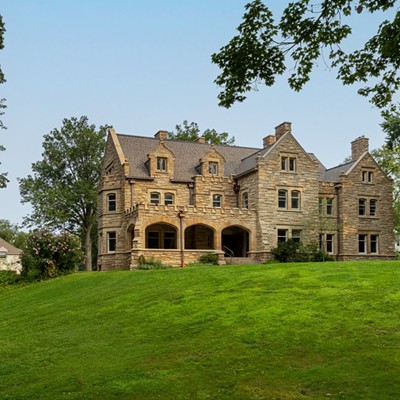It's hard not to reach out and run a fingertip across Susan Squires' seductive, mysterious encaustic-on-panel paintings. Geometric forms are scored into a ground of clear or milky wax, revealing lambent passages applied with oil sticks. Colors and shapes seem to float toward the eye, rising through dark fathoms (one work is composed of nine layers), as obscure harmonies gradually become discernable. Each painting is both reflective and inhabited by its own species of form.
Squires says the basic gesture of her work is twofold: looking down and looking up, uniting earth and sky as she mixes multiple perspectives. In several paintings at her Intown Club solo show, constellation-like configurations are scratched into an underlying grid inspired by ancient floor tiles. But such images are relatively incidental; the medium is the main message in her work. Squires makes her own bees' wax and varnish mix, and while each work includes a variety of elements, among them collage and tiny, delicate diagrams gleaned from antique texts and printed into the wax by a transfer process, the information they convey is adrift in a dimension that resists any focus. Squires' wax is like semi-transparent flesh, both yielding and firm, growing around the incidents of a life. To look at it is also to absorb something of its texture, reaching across the gulf between the senses and separating selves. Squires' techniques evoke the tender, physical basis of memory. Almost everything in her paintings is literally in it, laid down as if subcutaneously, rubbed into the muscle of time past.
One of her newest, largest works was painted recently during a visit to Florida. Titled "Naples," it's built from abraded patches of color and wax, like Squires' other mainly abstract surfaces. But here these elements take on a new solidity, becoming recognizable landscape references — sea and sunlight, sand and vegetation. All are contained in the distinct compartments of a loose grid, as if an alchemist had separated out the elements of a day at the beach. "Overview 2," another 2009 work, takes the process of distillation further, presenting a column of six sections that read like serial patches of earth, water, and sky — a core sample of natural subject matter.
The Intown Club, which hosts several exhibits of contemporary art a year — along with lectures, recitals and other activities — is worth a visit on its own account. Opened as a private club in 1928, it moved to its present location on the third floor of the Stouffer Building on PlayhouseSquare (mainly known these days as the home of the Idea Center, Ideastream's broadcasting nerve center) in 1934 and has been going strong ever since. Shows are on view by appointment only, so call before making the trek downtown.











